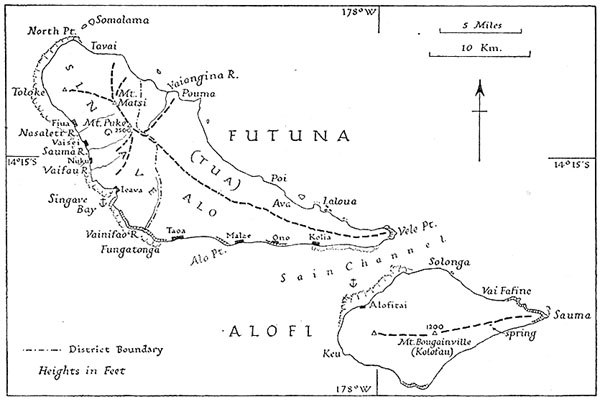APAC140
From Marist Studies
Jump to navigationJump to search
Excursus D : Futuna at war!
Printer friendly version of Excursus D
- In July 1839, only a little more than a year since the last war,[1] the deep-seated resentments of the vanquished, the Lava, in Singave, against the victors, the Malo, living in the part of the island called Tua, were working their way up again to the surface.[2] Young Singave hooligans raided Tua hamlets, and while the old men proclaimed their loyalty to Niuliki, they were in fact scheming to bring him down. They would sit down to negotiate, promise to rein in the young hotheads, but at home they expressed regret when the young men returned home without having killed a Malo. The ancestral gods spoke loudly of revenge,[3] and war cries resounded at the background of peace initiatives. A whaler from Sydney sold muskets and powder at the price of ten pigs apiece, chiefs around the old Vanae (the senior Singave chief) shouted the old war songs and kava was offered him with the ceremonial usually reserved to Niuliki. Peter Chanel walked all over Singave with Thomas Boag and observed the mysterious rituals that nobody wanted to explain. On the point of returning to Poi, where Marie-Nizier was by himself, they were asked by the Singaves not to tell the Malo about what they had seen. Chanel did his best to turn the tide, but in vain.[4] They got hold of more muskets (four pigs apiece) and one young man badly hurt himself trying out his musket with a bag of powder between the legs! On 9 August the Singave crowd bought another ten muskets.

- The next day Niuliki prepared a meal he wanted to present to the Singave elders as a sign of goodwill but when he got to the creek Tuatafa, he ran into open warfare. The Singaves were outnumbered two to one but initially they managed to throw the Tua back. After one or two volleys the guns were useless, and a pitched battle followed with spears, lances and war-clubs. The young Singave warriors ran, leaving their elders to die on the field.[5] The wounded were mostly massacred on the spot, as well as an Englishman, William Peel, who had joined the Singave side.
- That day Singave lost eighteen men, mostly elders. Only a few of the wounded survived. The Tua lost ten men but had a large number of wounded, many of whom died later on.[6] Niuliki himself had received spear through his shoulder. He appealed to Chanel and Marie-Nizier who had remained in Poi the entire day, to care for the wounded, which showed, Chanel thought, people’s openness to the lotu. The victorious Tua rampaged all over Singave, burning houses, killing pigs, cutting down trees and destroying food gardens. Late in the evening they returned home, shouting victory and carrying the spoils of war. They also carried the Englishman Moara (Moore?) whom they had captured in Singave, stripped nearly naked. They offered the missionaries some of the seized pork but Chanel refused.[7]
- For days the Futunans of both sides were busy burying the dead and carrying the wounded to their villages. Once the fighting was over, the lava gradually came down from the densely wooded mountainsides where they had taken refuge, and presented the symbols of submission to King Niuliki, who accepted the surrender magnanimously.[8] The actual fighting had been extremely bloody, but warfare on Futuna was in no way vicious savagery. Women and children had not been hurt and no revenge was taken once the fighting ended.[9] Within a few weeks Chanel observed Singave people working on fine new taro gardens.[10]
- Unlike some Europeans on the island the two missionaries had remained strictly impartial, but for many days they were very busy, caring for the wounded, removing spears and arrows from bleeding bodies, and consoling the bereaved. Peter Chanel cried when he saw the mutilations of the wounded and the humiliation of the vanquished offering their submission. ‘From that time’, he wrote later to Bishop Devie, ‘people’s minds seem better disposed towards the religion than before’.[11]
Notes
- ↑ I.e. around the end of April 1838, when Chanel returned from Wallis, cf. above, p. 94.
- ↑ The people of the eastern part of the island, often referred to as Tua, won the last war against those of the western part of the island, Singave. The constant speaking of victors and vanquished, i.e., of lava and malo, fed hostile feelings.
- ↑ Through priestesses or old men in a trance.
- ↑ EC, doc. 56 [4].
- ↑ Chanel later wrote that this was not unusual. 56[5].
- ↑ A few weeks later Chanel gave 23 dead for Singave and 12 for Tua, EC, doc. 53 [14], with several wounded still in danger of death. The final tally, on 27 November, stood at 24 against 13. EC, doc. 57 [4].
- ↑ EC, doc. 56 [5].
- ↑ The same thing happened two months later, cf. EC, p. 471, 27 October.
- ↑ EC, p. 458, 21 August.
- ↑ EC, p. 464, 10 September.
- ↑ Chanel has left us two lengthy and detailed accounts of the war: his diary for 10 August, EC, p. 453ff, and his letter to Bataillon, 7 September, EC, doc. 51 [2 - 4]; and one shorter account to Bishop Devie in November (or later), EC, doc. 56 [5]. Other accounts of this war can be found in Nizier to Champagnat 30.09.39, LO, Clisby 011 [22 - 28], and in Twyning, Shipwreck and Adventures of John P. Twyning among the South Sea Islanders, pp. 120 - 127. What Twyning tells of his own role in the events shows some resemblance to the unnamed Englishman whom Nizier mentions in [23].
| Previous Section | A Piety Able to Cope | Next Section |